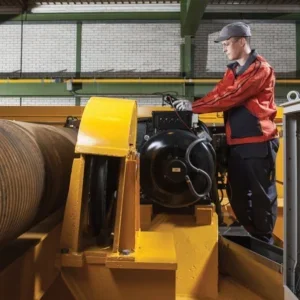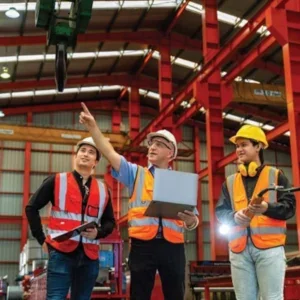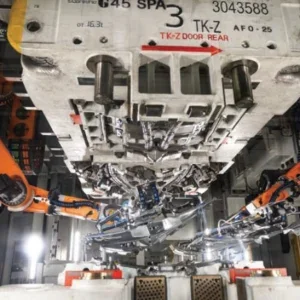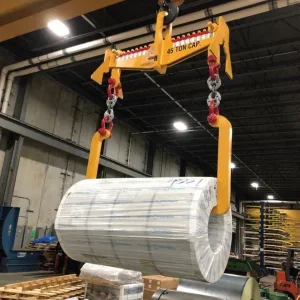Contractors often need high-performance 80-500t equipment to lift large concrete segments, sometimes weighing over 100t, in remote casting yards and bring them to site. The options available include gantries on rails or straddle carriers.
Leading crane manufacturers Cengin, Comtec, and Anupam build this kind of equipment to service the current rapid development of infrastructure across Asia.
In producing this equipment they too are following the global trend towards modular construction using off-site fabrication of precast concrete. Precast concrete is cured in factory-like casting yards rather than in-situ on construction sites, which results in sturdier concrete segments. The US government’s Federal Highway Administration reports that modular panels make the construction of highways in the country safer, since it results in more durable roads, as well as faster and cheaper for road operators, as it allows more work to be done at night when there is less traffic.
While in the US trucks can transport precast segments from the casting site to the construction site, in Asia where road conditions may be poor and casting sites are often remote, gantry cranes are frequently chosen for this work.
Straddling the globe
A major global player in the provision of concrete moving equipment, Comtec in Italy, supplies construction gantries and straddle carriers. In addition, it manufactures overhead span launchers for bridge construction.
Comtec has seen success with its concrete straddle carriers and sells them on nearly every continent. It produces them for clients in countries including Greece, Romania, the US and Brazil.
It has extensive experience working in Middle Eastern countries like Qatar, Dubai and Saudi Arabia. In Asia it supplies to Korea, Malaysia, and Taiwan for example.
Comtec equipment primarily used to move or cast concrete segments includes straddle carriers, trolleys and rail-mounted gantry cranes. Working in tandem, two 140t Comtec straddle carriers can move long concrete segments.
When it comes to moving large concrete segments, Comtec’s clients can be either contractors or subcontractors involved in major construction projects.
Comtec offers the additional option of renting canes for cost-focused clients. Comtec commercial director Enrico Mascheroni comments: "Normally we sell the cranes to them, but if we have something second-hand available we are open to rent them also.
While Masheroni stresses that every gantry is designed as per client wishes, and custom capacities can range up to several hundred tonnes, he says that the 100t capacity model is much requested.
Some of Comtec’s past projects in Asia include the manufacture of 140t straddle carriers used in concrete yards in Malaysia.
In Kuala Lumpur, Malaysia it supplied 80t straddle carriers to MTD ACPI Engineering. MTD ACPI, based in Malaysia, is an investment company engaged in the construction of mountain roads, highways, bridges, and highway maintenance. It also builds precast concrete products for infrastructure projects.
The group builds infrastructure in Asia and the Middle East for projects such as the Jamarat Bridge in Saudi Arabia and India’s Delhi Metro. MTD ACPI used Comtec straddle carriers to move segments while doing construction work on the Kelana Jaya Line in Kuala Lumpur, Malaysia, a medium-capacity light rail transport system. In operation since September 1998, the Kelana Jaya Line is one of three rail transit lines operated by the RapidKL rail network as part of Kuala Lumpur’s rail transit system. It was formerly known as PUTRA after the company that developed and operated it, Projek Usahasama Transit Ringan Automatik. On that site MTD ACPI used the straddle carriers to move precast segmental box girders, tunnel lining, parapets, planter boxes and station platforms.
Apart from moving concrete segments, another application for large construction gantry cranes is the assembly of tunnel boring machines (TBMs).
Last year Comtec supplied a 320t gantry crane to Italian contractor Toto General Construction (Toto Costruzioni Generali).
The company used the gantry crane to lift what is currently the biggest tunnel boring machine (TBM) in the world, ‘Martina’, located on the jobsite for the A1 Highway at Pian del Voglio in Italy. The components of the TBM had a total height of 15.62m, equal to the height of a five-storey building, and a length of 130m.
Comtec tested the ultra-large gantry crane before delivering it to the Port of Ravenna on three connected trailers towed by two tractors.
Mascheroni says that Comtec’s future plans for developing its construction equipment segments are unclear thanks to the ongoing Eurozone crisis.
"We are continuing our job, but it’s difficult to make a plan for the future at this moment due to the big economic crisis. It depends on the market situation."
Bridge segments for India
In India many infrastructure projects are planned to meet demand fueled by its burgeoning economy. While highways are being widened and extended, high-speed rail will also be introduced this year. Monorail systems are currently under construction in seven cities. Both the Monorail Mumbai and the Thiruvananthapuram Monorail will be complete in 2016.
Established 39 years ago, India-based Anupam supplies overhead cranes and gantries for many sectors.
The company claims it has one of the largest market shares in India, installing cranes and gantries to move power plant equipment for clients such as Siemens, Tata Group and Samsung.
Producing a wide array of gantry cranes, it builds them not only for power, material handling and water gate lifting but also, increasingly, for metro and bridge construction. For the construction sector, it supplies both gantry and tower cranes. Its Anupam-Alfa tower cranes are built in association with Italian tower crane builder Alfa and used to build real estate.
Some of its construction sector clients include GMR Group, Reliance Infrastructure, and Jaypee Group.
Anupam has seen increasing demand for this sector in recent years, coinciding with a rise in infrastructure and real estate construction in India.
"We foresee a remarkable growth in the coming years in these equipments in the domestic market," says Anupam.
The company’s main construction gantry crane market is in India, where it supplies gantry cranes for moving concrete materials or removing rubble on tunnel construction projects. Major construction companies use the gantry cranes to move precast concrete from the site of fabrication to the construction sites, where they are then lifted into place by a mobile crane. Some concrete producers also order custom gantries for moving concrete slabs around casting yards.
Construction gantries used for transport are often fitted with cable drums that reel out to a generator. The only limitation on the distance they can travel is the length of the power cable, which often reels over long distances to reach lengths as great as half a kilometre.
Anupam’s gantries in this segment may be single or double girder gantry cranes, or even goliath cranes with capacities ranging up as high as 500t.
Construction gantries are custom-built for end users, says Anupam’s senior manager for corporate communications, Suvendu Senapati.
"These cranes normally are customised. For specific requirements there is no renting business, particularly in the gantry cranes category.
"However there is a good market for tower crane renting. Often the rental companies will buy tower cranes from us to rent to contractors themselves."
Anupam has supplied a construction gantry crane with a 120t capacity for Maytas Infrastructure, an Indian infrastructure development, construction and project management company.
Maytas Infrastructure used the large gantry crane to transport concrete for bridge construction.
Casting yards require a similar large capacity crane that can move around the site, delivering heavy concrete loads.
One such Anupam client is Larsen and Toubro, which performs construction contracting as well as cement manufacturing through its subsidiary Larsen and Toubro Concrete.
Anupam Industries managing director Mehul Patel explains: "Recently Anupam has supplied many large size gantry cranes to L&T for its casting yards.
"Anupam has also supplied large, high speed gantry cranes to Hindustan Construction Company (HCC), India for their hydro-power projects."
Anupam also serves other sectors in Asia, besides the power and tunnelling industries, that are currently enjoying booming demand. For example, it also builds container cranes for ports.
Last year the company established a joint venture with Mitsubishi Heavy Industries (MHI) to form Anupam-MHI Industries. This joint venture company makes container cranes, furthering Anupam’s stated goal of assisting Asian ports looking to increase their current handling capacities.
While to date Anupam only supplies construction cranes in India, the company plans to expand its distribution network through East Asia, Brazil and Russia. It is also planning to extend its service network to other countries to enhance its export business. To increase its range of offerings for the construction sector, the company also plans to expand its tower crane product range and launch standardised gantry cranes for its construction segment.
Moving quay wall pillars
Shanghai Cengin, established 35 years ago in China, is a catch-all builder of material handling equipment for manufacturing, ports, marine and construction sectors, producing everything from overhead factory cranes to jack-up barges.
It has been an OEM supplier of crane parts for Konecranes, Demag and Abus.
It started exporting in 2007, and has established representative offices in Brazil, India and the US.
Cengin provides products inspired by European designs, it says, having improved its controls technology.
Examples of this include its variable voltage and variable frequency (VVVF) technology along with its programmable logic controller (PLC).
Cengin supplies countries closer to home, including Korea, India, and across Southeast Asia.
For construction markets it builds gantry cranes, tower cranes and derricks as well as launching girders. These are used in road and railway construction and for precast concrete casting yards.
Cengin marketing director Damon Zhao explains the company has construction gantry clients in Japan and the Middle East. "Our customers include a Japanese construction contractor ranking tenth in the world and the biggest shipyard in the Middle East.
"Shipyards, precast industry, road and bridge construction, and plant construction are our four major client groups.
"The end users, trading companies, engineering and building contractors are our most important clients."
Cengin’s construction segment includes gantries used to handle materials for the construction of underground railway lines and TBM assembly.
"Also, some other industries need our gantry cranes for some special uses, for example, to assemble TBMs for tunnel projects," says Zhao.
Cengin’s custom gantry crane capacities and models are most popular for bridges, roads and other construction work.
Cengin recently provided two sets of 100t gantry cranes on rails for building a quay wall at Arab Shipbuilding & Repair Yard (ASRY) in Hidd, Bahrain.
The 100t gantries lifted 3,000 concrete beams over two and a half years, and completed the quay wall in December 2011. The cranes were designed to work under harsh port conditions.
"The work site environment is near the sea, with high temperature, high humidity, high corrosion," says Zhao.
Cengin plans to expand its international presence via exhibition attendance, through which it seeks to form new distribution partnerships. It intends for products sold through such networks to be competitive in terms of both design and cost, says Zhao.
"First of all, Cengin will actively participate in worldwide professional exhibitions, which helps us to introduce our design, manufacturing, service advantage to global clients. Secondly, we will strengthen the marketing network, so that our information can be efficiently and accurately conveyed to every corner of the world. That also allows clients to quickly locate us." At these exhibitions, Cengin will reach out to potential distributors outside of China, Zhao says.
"We believe that we can achieve a win-win future based on our unique design, manufacturing and cost advantages and distributors’ local marketing ability to develop more market share."






